Features:-

At home in your hands.
A deep grip design and balanced weight feel great with both NIKKOR Z and F-Mount NIKKOR lenses and the Mount Adapter FTZ adapter. Buttons and dials are comfortably placed—features like the sub-selector and AF-On button are in the same position as the D850. Unmistakably Nikon.
Big performance.
Small footprint.
One of the major benefits of the Z 7’s thin 16mm flange back distance is that cameras can be made smaller and lighter. The Z 7 is 26% lighter than the D850, yet it maintains outstanding handling and balance, even when using telephoto F-Mount NIKKOR lenses. It’s as comfortable to carry as it is to shoot with.


Flagship Nikon durability.
A skeleton forged from ultra-strong Magnesium Alloy, the same material used in the D850 and D5 for its extreme durability and incredible strength-to-weight ratio. The same brake mechanism and shutter blade material used in the D850, tested for 200,000 cycles while actually loaded in the camera. The Z 7 is ready for the field.
NEW NIKKOR Z LENSES
The next generation of NIKKOR glass.
Empowered by the larger Z Mount and shorter 16mm flange focal distance, NIKKOR Z lenses gather more light and break traditional rules of the “sweet spot”. Forget about stopping down for maximum sharpness—NIKKOR Z are at their best and deliver corner-to-corner sharpness even at their widest aperture.
Legendary F-Mount NIKKOR Lenses
Greater performance from the lenses you love.
When used with the optional Mount Adapter FTZ, more than 90 F-Mount NIKKOR lenses maintain all of their sharpness, resolving power and functionality and gain the advantages of the Z 7’s in-body VR, silent shooting, PDAF focusing system,¹ 4K video and more. Approximately 360 F-Mount NIKKOR lenses can be used. Compatibility as only Nikon can deliver.
493-Point Hybrid AF System
Focus on what matters.

493-Point On-Sensor PDAF
493² on-sensor AF points cover 90% of the frame (approx.) horizontally and vertically. Subjects are acquired quickly when they enter the frame and tracked throughout the frame, even to the far edges.

New Hybrid Autofocus
Using an AF algorithm optimised for its FX-format sensor, Z 7 automatically switches between focal-plane phase-detect AF and contrast-detect AF to fine-tune focus. The light-shielding phase detection pixels are carefully arranged on the sensor to preserve light, ensuring accurate AF even in dim lighting.

New Subject Tracking
Whether shooting eye-level with the EVF or in Live View with the LCD, Auto Area AF smoothly tracks your subject. For example, when shooting portraits, the system pays attention to the upper body, too, maintaining focus position when your subject briefly turns away from the camera or moves out of view.
Get the latest Subject Tracking performance which requires Firmware 3.0.

Eye-Detection AF
Eye-Detection AF is a powerful tool for capturing portraits that tracks and locks focus on your subject’s eye not only with AF-S (Single AF) mode, but also with AF-C (Continuous AF) mode—especially useful when your subject keeps changing their pose. Eye-Detection AF is also capable of intelligently recognising the eyes of multiple people in the frame, giving you the freedom to choose which person and eye to focus on and can even remain locked on eyes that become partially or temporarily obstructed.

New Animal Detection AF
Capture still images when focus has been acquired on a dog or cat’s eye, even in situations that were previously difficult for auto-area AF. When shooting video dog or cat’s face can be detected.
Pure Viewing Experience
Just like the real thing.

New 3.6M-Dot Quad VGA Viewfinder.
Oh, what a view.
Take an ultra-high resolution QUAD VGA display, add Nikon optics for magnification, including Aspherical lens elements and Fluorine coating, and you’ve got an EVF experience unlike any before it. Minimal lag and blackout, 100% frame coverage (approx.), corner-to-corner clarity and sharp magnification. It has the feel of an optical viewfinder, and you can use it for both stills and videos.

New Icon-Driven Info Display
Keep your eye on the prize.
All relevant info is displayed out of the way and is easy on the eyes. A new customisable menu appears right inside the viewfinder, so you can quickly adjust settings without ever taking your eye off the shot. Focus modes, white balance, exposure, VR settings, Picture Controls, and more—all within eye’s reach. Preview exposure and white balance changes, image stabilisation and depth-of-field in real time. You can even review the photo or video you just shot.

Up to 5 Stops of VR Image Stabilisation
Powerful in-body 5-axis VR image stabilisation is applied to whatever NIKKOR Z lens you’re using. Up to five stops³ of image stabilisation in up to five directions—yaw, pitch, roll, X and Y. During video recording, optical VR is combined with electronic VR (e-VR) for even steadier shots. Normal VR mode for static subjects. Sports VR for moving subjects.

VR for F-Mount NIKKOR Lenses
For the first time, F-Mount NIKKOR lenses like the AF-S NIKKOR 105mm f/1.4E ED or AF-S NIKKOR 14-24mm f/2.8G ED can benefit from in-body 3-axis VR.⁴ NIKKOR lenses that already have VR, like the AF-S NIKKOR 70-200mm f/2.8E FL ED VR, get the added benefit of roll axis for a total of 3-axis VR. Just add the optional Mount Adapter FTZ and you’re good to go.

New Built-In Timecode
All of your Z 7 footage can be time-coded in-camera for easier synchronising and logging, especially when editing shots from multi-camera shoots.
Slow Motion Videos
Capture every detail of movement with 120 FPS. Then play them back at 30, 25 or 24 FPS for jaw-dropping, fluid slow motion in 1080p High Definition.


Focus pulling optional
Four AF-area modes for videos: Single-Point AF, Wide-Area AF (S or L) and Auto-Area AF. Seamless automatic switching between Phase Detect and Contrast Detect AF based on the situation. Mimic focus pulling techniques by controlling when AF starts and stops in AF-C mode using AF speed and AF tracking sensitivity options.

New 10-Bit HDMI Output
What’s the difference between 8-bit and 10-bit recording? Only about 1 billion more colours (64X more data)—so much more flexibility in post-processing. Record directly to an optional external recorder with 10-bit output via HDMI, the industry standard. Simultaneously record uncompressed 8-bit 4K UHD movie files to the memory card and an external recorder. (Atomos Open Protocol supported for syncing start/stop.)

Smooth, Quiet AF
The speed, smoothness and accuracy of the Z 7’s AF system is ideal for video. It’s virtually silent, very little chance it will be picked up by an external mic. When used with NIKKOR Z lenses, “breathing” and “wobbling” are all but eliminated. You can even touch to focus using the LCD for fast transitions between subjects.

ISO 64 (Expandable to ISO 32)
Increased light capture means you can shoot at lower sensitivity more often. And the lower the sensitivity, the greater the detail, colour range and contrast.

ISO 25,600 (Expandable to 102,400)
More light gathering potential, flawless EXPEED 6 noise reduction and new NIKKOR Z lenses free you to explore the darker side of light with entirely new brilliance.

Remote Shooting
With SnapBridge version 2.5 or greater, you can also use your compatible smartphone as a remote monitor and controller. Touch focus, adjust settings like exposure mode, white balance and more, then fire the shutter.

New USB Battery Charging
For the first time in a full-frame Nikon camera, you can charge the Z 7’s new EN-EL15b battery in the camera through a standard USB-C connection—from your computer, a wall outlet or other charging device.⁸ Already have EN-EL15a/EN-EL15 batteries?⁹ They work with the Z 7, too.

New connectivity
Connect to a Mac or PC over Wi-Fi and wirelessly transfer RAW, JPEG and movie files. Two modes available: Camera Access Point mode, for connecting directly to a PC, and Station (STA) mode, for connecting over a router.¹⁰

Brilliant. Bright. Stunning.
The beautiful high-resolution touchscreen is as sharp and clear as a smartphone. 8 cm (3.2-inches). 2.1-million dots. Crystal clear and vibrant. Tilt for shooting at high and low angles. Touchscreen control. This display is a smooth operator.
Like using a smartphone.
Nikon takes touchscreen control to the next level. Touch to focus. Pinch to zoom. Touch to fire the shutter. Swipe through photos and videos. Navigate settings as easily as navigating a smartphone. Pinch to magnify the image on-screen to check for critical sharpness. We’re living in a touchscreen world, and this is a touchscreen camera.


Sharper, clearer menus.
Totally familiar for a Nikon DSLR shooter, fast and intuitive for someone new to the Nikon system. Z 7’s menus and user interface are elegant, clear and easy to navigate with touch control. Easily add your favourite functions to the (i) menu—over 30 settings available—then access them from the LCD or EVF.
Remote Shooting and Rf Speedlight Control
Capture and create remotely.
Take control of the light with any compatible Nikon Speedlight. Use the optional WR-R10 Wireless Remote Controller for wirelessly controlling SB-5000 Speedlights from another room, around corners or outdoors in bright sunlight. Advanced Wireless Lighting using optically controlled Speedlights like the SB-700 and SB-500 is also possible. For remote shooting, the WR-1 and WR-R10 Wireless Remote Controllers can be used.
Specifications:-
Display SKU VOA070BN
Type Digital camera with support for interchangeable lenses
Lens Mount Nikon Z mount
Picture Angle Full-frame/FX-format
Image Sensor
Sensor Size 35.9 mm x 23.9 mm
Image Sensor Type CMOS
Total Pixels 46.89 million
Dust-Reduction System Image Dust Off reference data (requires Capture NX-D); image sensor cleaning
Image Area (pixels) Image Area (L) FX 8,256 x 5,504 (Large) 6,192 x 4,128 (Medium) 4,128 x 2,752 (Small) Image Area (L) DX 5,408 x 3,600 (Large) 4,048 x 2,696 (Medium) 2,704 x 1,800 (Small) Image Area (L) 5:4 (30 x 24) 6,880 x 5,504 (Large) 5,152 x 4,120 (Medium) 3,440 x 2,752 (Small) Image Area (L) 1:1 (24 x 24) 5,504 x 5,504 (Large) 4,128 x 4,128 (Medium) 2,752 x 2,752 (Small) Image Area (L) 16:9 (36 x 20) 8,256 x 4,640 (Large) 6,192 x 3,480 (Medium) 4,128 x 2,320 (Small) Photographs taken during movie recording at a frame size of 3,840 x 2,160: 3,840 x 2,160 Photographs taken during movie recording at other frame sizes: 1,920 x 1,080: 1,920 x 1,080
Effective Pixels (Megapixels) 45.7 million
Image Sensor Format Full-frame/FX-format
Movie
Movie 4K UHD 3,840×2,160 / 60 fps 4K UHD 3,840×2,160 / 50 fps 4K UHD 3,840×2,160 / 30 fps 4K UHD 3,840×2,160 / 25 fps 4K UHD 3,840×2,160 / 24 fps Full HD 1,920×1,080 / 120 fps Full HD 1,920×1,080 / 100 fps Full HD 1,920×1,080 / 60 fps Full HD 1,920×1,080 / 50 fps Full HD 1,920×1,080 / 30 fps Full HD 1,920×1,080 / 25 fps Full HD 1,920×1,080 / 24 fps Full HD 1,920×1,080 slow-mo / 30 fps x4 Full HD 1,920×1,080 slow-mo / 25 fps x4 Full HD 1,920×1,080 slow-mo / 24 fps x5 Actual frame rates for 120p, 100p, 60p, 50p, 30p, 25p, and 24p are 119.88, 100, 59.94, 50, 29.97, 25, and 23.976 fps respectively Quality selection available at all sizes except 3,840 x 2,160, 1,920 x 1,080 120p/100p, and 1,920 x 1,080 slow-motion, when quality is fixed at m
Movie Metering TTL exposure metering using main image sensor
Time-Lapse Movie Up to 4K UHD; Silent mode option
Movie HDMI Output Yes, up to 12 bit Start/Stop supported
Movie Log Gamma Output Logarithmic (N-Log) and HDR (HLG) movie output with View Assist (HDMI output only)
Time Code Yes Drop frame
Movie Active D-Lighting Can be selected from: Auto, Extra High, High, Normal, Low, or Off
Movie ISO Auto ISO sensitivity control (ISO 64 to 25,600) M: Manual selection (ISO 64 to 25,600; choose from step sizes of 1/3 and 1/2 EV); with additional options available equivalent to approximately 0.3, 0.5, 0.7, 1, or 2 EV (ISO 102,400 equivalent) above ISO 25,600; auto ISO sensitivity control (ISO 64 to Hi 2.0) available with selectable upper limit P, S, A: Auto ISO sensitivity control (ISO 64 to Hi 2) with selectable upper limit
Movie Audio Built-in stereo or external microphone with attenuator option; sensitivity can be adjusted
Movie Audio Recording Format Linear PCM AAC
Movie Video Compression H.264/MPEG-4 Advanced Video Coding
Movie File Format MOV MP4
Movie Maximum Recording Time 29 minutes 59 seconds
Movie Frame size (pixels) and frame rate n/a
AF for Movie AF Speed and AF Tracking Sensitivity can be adjusted
File System
File Format Still Images NEF (RAW): 12 or 14 bit (lossless compressed, compressed, or uncompressed); large, medium, and small available (medium and small images are recorded at a bit depth of 12 bits using lossless compression) JPEG: JPEG-Baseline compliant with fine (approx. 1:4), normal (approx. 1:8), or basic (approx. 1:16) compression; optimal quality compression available NEF (RAW) + JPEG: Single photograph recorded in both NEF (RAW) and JPEG formats
Picture Control Auto Standard Neutral Vivid Monochrome Portrait Landscape Flat Creative Picture Controls: (Dream, Morning, Pop, Sunday, Somber, Dramatic, Silence, Bleached, Melancholic, Pure, Denim, Toy, Sepia, Blue, Red, Pink, Charcoal, Graphite, Binary, Carbon) Selected Picture Control can be modified Storage for custom Picture Controls
File System DCF 2.0 Exif 2.31
Storage Media CFexpress (Type B) XQD Type Memory SD (Secure Digital) and UHS-II compliant SDHC and SDXC memory cards
Card Slot Dual Slots
Viewfinder
Viewfinder 1.27-cm (0.5-in.) approx. 3690k-dot (Quad VGA) OLED with colour balance and auto and 11-level manual brightness controls
Eye Sensor Automatically switches between monitor and viewfinder displays
Compatible Lenses Z mount NIKKOR lenses F mount NIKKOR lenses with mount adapter; restrictions may apply
Lens Compatibility at a Glance*** Z mount NIKKOR lenses F mount NIKKOR lenses with mount adapter; restrictions may apply
Depth-of-Field Control Yes
Reflex Mirror n/a
Viewfinder Diopter Adjustment -4 to +2 m-1
Viewfinder Eyepoint 21 mm (-1.0 m-1; from center surface of viewfinder eyepiece lens)
Viewfinder Magnification Approx. 0.8x (50 mm lens at infinity, -1.0 m -1)
Viewfinder Frame Coverage Approx. 100% horizontal and 100% vertical
Focusing Screen n/a
Shutter
Shutter Type Electronically-controlled vertical-travel focal-plane mechanical shutter; electronic front-curtain shutter; electronic shutter
Frame Advance Rate Low-speed continuous: 1-5 fps High-speed continuous: 5.5 fps (14-bit NEF/RAW: Approx. 5 fps) High-speed continuous (extended): 10 fps (14-bit NEF/RAW: Approx. 9 fps) Maximum frame advance rate as measured by in house tests
Shutter Release Modes Single frame Low-speed continuous High-speed continuous High-speed continuous (extended) Self-timer
Flash Sync Speed X=1/200 sec.; synchronizes with shutter at 1/200 sec. or slower; Auto FP High-Speed sync supported
Continuous Shooting Options Low-speed continuous: 1-5 fps High-speed continuous: 5.5 fps (14-bit NEF/RAW: Approx. 5 fps) High-speed continuous (extended): 10 fps (14-bit NEF/RAW: Approx. 9 fps) Maximum frame advance rate as measured by in house tests
Self-timer 2, 5, 10, 20 sec.; 1-9 exposures at intervals of 0.5, 1, 2, or 3 sec.
Slowest Shutter Speed 900 sec
Fastest Shutter Speed 1/8000 sec
Exposure
Exposure Metering TTL metering using camera image sensor
Exposure Modes Auto Programmed auto with flexible program (P) Shutter-priority auto (S) Aperture-priority auto (A) Manual (M) User settings (U1, U2, U3)
Exposure Lock Luminosity locked at detected value
Exposure Bracketing Yes
Exposure Compensation -5 to +5 EV in increments of 1/3 or 1/2 EV available in modes P, S, A, and M
Scene Modes n/a
Exposure Meter Coupling CPU
Metering Range -3 to +17 EV (ISO 100, f/2.0 lens, 20 °C/68 °F)
Metering Method Matrix metering Center-weighted metering: Weight of 75% given to 12 mm circle in center of frame; weighting can instead be based on average of entire frame Spot metering: Meters 4 mm circle (about 1.5% of frame) centered on selected focus point Highlight-weighted metering
Mirror Lock Up n/a
Sensitivity
ISO Sensitivity ISO 64 – 25,600 in steps of 1/3 or 1/2 EV Can also be set to approx. 0.3, 0.5, 0.7, or 1 EV (ISO 32 equivalent) below ISO 64 or to approx. 0.3, 0.5, 0.7, 1, or 2 EV (ISO 102,400 equivalent) above ISO 25,600; auto ISO sensitivity control available
Single-Point AF Mode Yes
Active D-Lighting Can be selected from: Auto, Extra High, High, Normal, Low, or Off
Expanded ISO Sensitivity Options n/a
Highest Expanded ISO Sensitivity 102400
Lowest Expanded ISO Sensitivity 32
Highest Standard ISO Sensitivity 25600
Lowest Standard ISO Sensitivity 64
Focus / Autofocus
Focus Point 493 (single-point AF)
Top FP High Speed Sync Up to 1/8000 sec.
X-Sync Speed 1/200th sec.
Built-in Flash Distance n/a
Focus Modes Pinpoint Single-point Dynamic-area AF Wide-area AF (S) Wide-area AF (L) Auto-area AF Pinpoint and Dynamic-area AF available in photo mode only
AF-Area Mode Pinpoint Single-point Dynamic-area AF Wide-area AF (S) Wide-area AF (L) Wide-area AF (L-people) Wide-area AF (L-animals) Auto-area AF Auto-area AF (people) Auto-area AF (animals) Pinpoint, Single-point and Dynamic-area AF available in photo mode only
Lens Servo Autofocus (AF): Single-servo AF (AF-S); continuous-servo AF (AF-C); full-time AF (AF-F; available only in movie mode); predictive focus tracking Manual focus (M): Electronic rangefinder can be used
VR (Vibration Reduction) Image Stabilization 5-axis image sensor shift
Detection Range -3 to +19 EV (-4 to +19 EV with low-light AF) Detection range (ISO 100, f/2.0 lens, 20 °C/68 °F)
Autofocus System Hybrid phase-detection/contrast AF with AF assist
Builtin Flash Zcamera n/a
Maximum Autofocus Areas/Points 493
Flash
Flash Compensation -3 to +1 EV in increments of 1/3 or 1/2 EV available in modes P, S, A, and M
Flash-ready Indicator Lights when optional flash unit is fully charged; flashes as underexposure warning after flash is fired at full output
Accessory Shoe ISO 518 hot-shoe with sync and data contacts and safety lock
Flash Control TTL: i-TTL flash control; i-TTL balanced fill-flash is used with matrix, center-weighted, and highlight-weighted metering, standard i-TTL fill-flash with spot metering
Flash Sync Modes Front-curtain sync Rear-curtain sync Red-eye reduction Red-eye reduction with slow sync Slow rear-curtain sync Slow sync Off
Nikon Creative Lighting System (CLS) i-TTL flash control, radio-controlled Advanced Wireless Lighting, optical Advanced Wireless Lighting, modeling illumination, FV lock, Color Information Communication, Auto FP High-Speed Sync, unified flash control
Flash Sync Terminal n/a
White Balance
White Balance Bracketing Yes
Live View Scene Auto Selector n/a
Live View Shooting Photography Live View Mode Movie Live View Mode
Monitor
Monitor Size 8-cm (3.2-in.) diagonal
Monitor Resolution approx. 2100k-dot
Monitor Type Tilting TFT Touch-Sensitive LCD
Monitor Angle of View 170° viewing angle
Monitor Adjustments Colour balance 11-level manual brightness controls
Playback
Voice Memo Function n/a
In-Camera Image Editing Distortion Control D-Lighting Image Overlay NEF (RAW) Processing Perspective Control Red-eye Reduction Resize Side by Side Comparison Straighten Trim Trim Movie
Playback Functions Auto Image Rotation Full-frame and thumbnail (4, 9, or 72 images) Highlights Histogram Display Location Data Display Movie Playback Photo and/or Movie Slide Shows Photo Information Picture Rating Playback with Playback Zoom Playback Zoom Cropping
Interface
Interface USB: Type C USB connector (SuperSpeed USB); connection to built-in USB port is recommended HDMI: Type C HDMI connector Accessory terminal: Can be used with MC-DC2 and other optional accessories Audio Input: Stereo mini-pin jack (3.5 mm diameter; plug-in power supported) Audio Output: Stereo mini-pin jack (3.5 mm diameter)
Wi-Fi Functionality Standards: IEEE 802.11b/g/n (Africa, Asia, Bolivia, and Oceania) Standards: IEEE 802.11b/g/n/a/ac (Europe, U.S.A., Canada, Mexico) Standards: IEEE 802.11b/g/n/a (other countries in the Americas) Operating frequency: 2412–2462 MHz (channel 11; Africa, Asia, Bolivia, and Oceania) Operating frequency: 2412–2462 MHz (channel 11) and 5180–5825 MHz (U.S.A., Canada, Mexico) Operating frequency: 2412–2462 MHz (channel 11) and 5180–5805 MHz (other countries in the Americas) Operating frequency: 2412–2462 MHz (channel 11) and 5745–5805 MHz (Georgia) Operating frequency: 2412–2462 MHz (channel 11) and 5180–5320 MHz (other European countries) Maximum output power (EIRP): 2.4 GHz band: 2.9 dBm Maximum output power (EIRP): 5 GHz band: 5.7 dBm (Georgia) Maximum output power (EIRP): 5 GHz band: 8.7 dBm (other countries) Authentication: Open system, WPA2-PSK
GPS Via the SnapBridge app
Total Custom Settings 54
Menus
Supported Languages English French Portuguese (Brazil) Spanish The languages available vary with the country or region in which the camera was originally purchased.
Date, Time and Daylight Savings Time Settings Yes
World Time Setting Yes
Power
Battery / Batteries One EN-EL15c rechargeable Li-ion battery EN-EL15b/EN-EL15a/EN-EL15 batteries can also be used. Note, however, that fewer pictures can be taken on a single charge than with the EN-EL15c. The EH-7P charging AC adapter can be used to charge EN-EL15c/EN-EL15b batteries only.
Battery Life (shots per charge) Photo Mode: Number of Shots Viewfinder only with Energy saving mode enabled: Approx. 380 shots Viewfinder only with Energy saving mode disabled: Approx. 360 shots Monitor only with Energy saving mode enabled: Approx. 440 shots Monitor only with Energy saving mode disabled: Approx. 420 shots Movie Mode: Length of Footage Viewfinder only: Approx. 100 minutes Monitor only: Approx. 105 minutes Camera and Imaging Products Association (CIPA) standard. Measured at 23 °C/73.4 °F (±2 °C/3.6 °F) with a NIKKOR Z 24–70mm f/4 S lens and a SONY CEB-G128 memory card under the following test conditions: one photograph taken at default settings once every 30 seconds. Actual battery endurance as measured under conditions specified by CIPA. Measured at 23 °C/73.4 °F (±2 °C/3.6 °F) with a NIKKOR Z 24–70mm f/4 S lens and a SONY CEB-G128 memory card. Measurement performed at default settings. Each shot can be up to 29 minutes 59 seconds in length. If camera temperature rises, recording may end before maximum length or size is reached.
AC Adapter EH-7P Charging AC Adapter EH-5d/EH-5c/EH-5b AC adapter; requires EP-5B power connector (available separately)
Battery Charger MH-25A Battery Charger
Miscellaneous
Weight (g) (body only)*1 Approx. 615g (21.7 oz.) camera body only
Length x height x width (mm) (body only)* 134mm x 100.5mm x 69.5mm (5.3 in. x 4.0in. x 2.8 in.)
Tripod Socket 0.635cm (1/4 in., ISO 1222)
4K UHD Yes
WiFi Yes
Bluetooth Yes

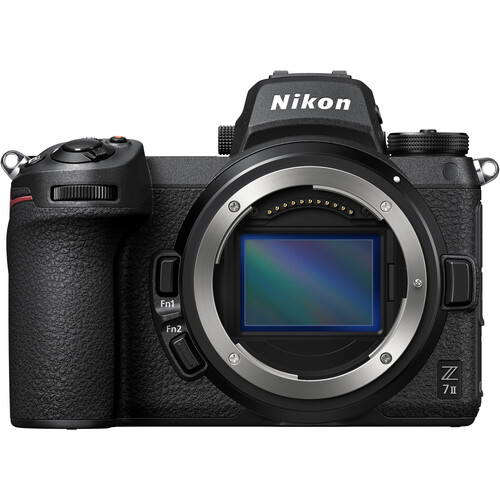
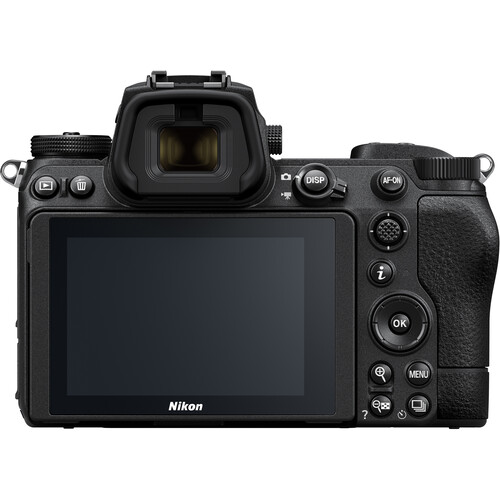
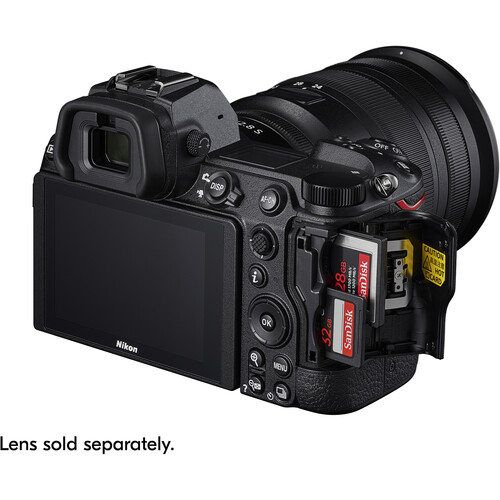
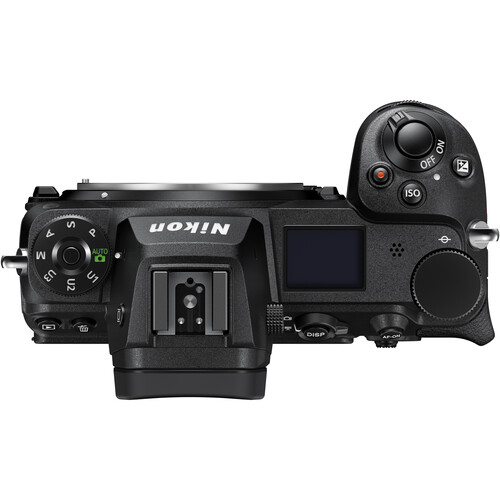
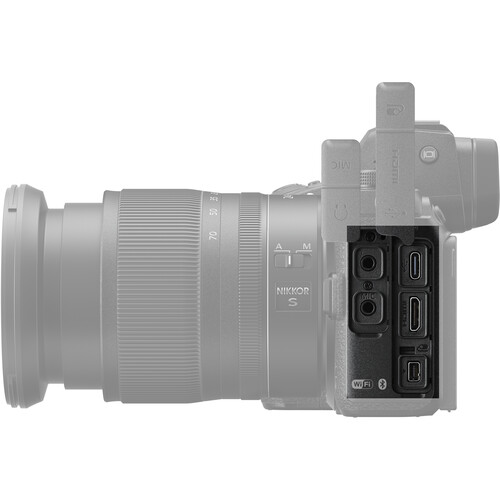

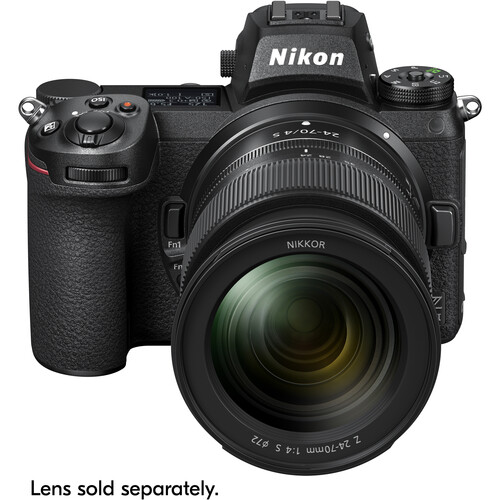
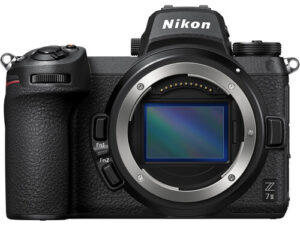

Reviews
There are no reviews yet.